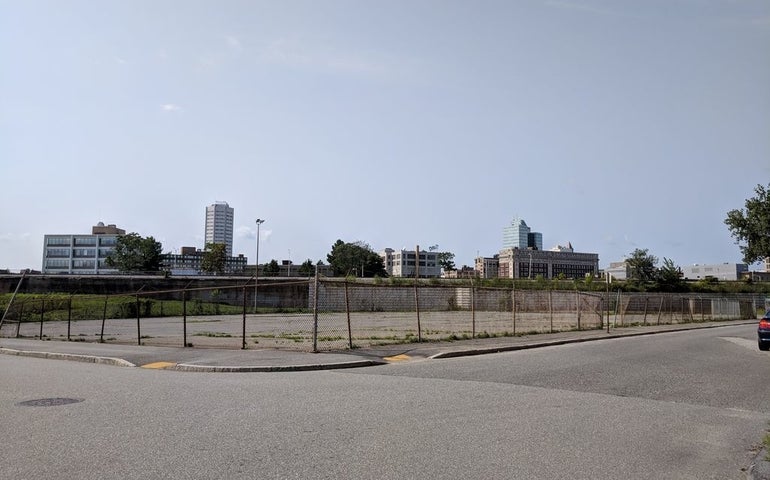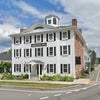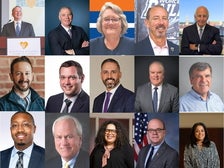Sports economists: $101M WooSox stadium deal unlikely to beat the odds
 Photo | Grant Welker
The proposed stadium site in Worcester's Canal District. Economists are doubtful the city's plan for a ballpark and related development will meet expectations.
Photo | Grant Welker
The proposed stadium site in Worcester's Canal District. Economists are doubtful the city's plan for a ballpark and related development will meet expectations.
Sports economists across the country sharply criticized Worcester’s plan to borrow $101 million to build a ballpark and surrounding hotel development to entice the Pawtucket Red Sox to move to the Canal District, saying Monday public benefits of such stadium deals are often minimal and the spillover effects overstated.
“It virtually never works,” said Nola Agha, a professor at the University of San Francisco who has written about economic effects of minor league stadiums.
After the announcement by the city and the team Friday of their signing a letter of intent to build a stadium in the Canal District, WBJ sent copies of the financing details to 10 economists and stadium experts around the nation to gauge whether Worcester’s claims over the stadium development paying for itself – without the need for current tax dollars – would come true.
Of those experts, the only one who spoke positively about the deal was the Smith College professor who was hired by the city to judge the economic viability of the offer to the PawSox. The rest doubted the stadium-pays-for-itself claims would come to fruition.
“There’s just mountains now of economic evidence that the payoff that’s promised and what actually happens is far different,” said Joel Maxcy, an economist at Drexel University in Philadelphia.
Those who specialize in studying public financing for sports facilities generally landed on a few conclusions:
- Money spent at a ballpark is money a resident or a family would likely have spent otherwise at a bowling alley or a concert. A stadium mostly just moves money around from one entity in a city or a region to another.
- The same goes for a restaurant near a stadium that might benefit from added traffic on a game night, only to take customers away from restaurants farther away, they said.
- Related development – like Worcester is planning on with hotels, apartments and restaurants – rarely lives up to expectations in economists’ view.
“The idea that this is going to serve as a catalyst for economic development, which is the hope – and I emphasize the word hope – is misguided,” Robert Baade, an economist at Lake Forest College in Illinois, said of Worcester’ stadium proposal.
The $101M proposal
City and PawSox officials pitched their proposal last Friday as one that could be transformative for the city by spurring new spending and development. They envision a park to draw thousands of fans on game days and for other public events there, for an expected total of 125 events per year.
A roughly $101-million mixed use development would rise in the Canal District as a result, with two hotels, 225 residential units and 65,000 square feet of retail space planned. The first phase of what is ultimately planned for 650,000 square feet of space is set to open in 2021, the same year the ballpark hosts its first game.
The ballpark proposal comes with proposed city and state investments to total at least $136 million.
The city is requesting to borrow $101 million, and to offer tax breaks for two new hotels and the housing development. The state has committed to $35 million for a parking garage and infrastructure work, and unspecified costs to redo Kelley Square.
City Council approval is needed for the city’s bond and for the tax breaks. The state said its $35 million share does not require legislative approval. Nearly all of that funding will be through the state's MassWorks infrastructure program, which typically gives in far smaller amounts. The largest recipient last year was a roughly $4.8 million project.
The state Department of Transportation did not give cost estimates for an overhaul of Kelley Square but said the department is proceeding with transportation infrastructure designs and anticipates advertising the construction contract by May 2019. The work is scheduled to be completed in 2021.
Worcester’s stadium financing plan calls on the city to create a special financing district surrounding the ballpark where the revenues collected from the developments inside the district – the hotels, apartments, any new restaurants, etc. – would cover the roughly $3 million in annual debt payments on the $101 million borrowed. In the city’s Friday press conference with the PawSox officials, city officials projected the special district would generate $3.7 million in 2021, exceeding the amount needed to cover the debt payments.
“In essence, the project pays for itself," City Manager Edward Augustus said at Friday’s press conference announcing the deal.
Worcester’s proposal struck sports economists as particularly generous to the team, with an especially high cost for a 10,000-seat ballpark.
Victor Matheson, a professor at the College of the Holy Cross in Worcester, is among the plan’s strongest critics. His views of the deal aren’t as optimistic as when he first heard just the basic details of the proposal.
“This is an extraordinarily expensive stadium,” he said, calling a $85-million to $95-million project cost misleading for not including site acquisition and other costs.
Matheson said he was surprised that Worcester officials committed to so much money for the stadium with what he said is so little in return. The city, which would own the ballpark, would allow the team to keep advertising and concession revenue at the stadium and revenue from a planned naming rights deal with Polar Beverages.
“They seemed to be smarter than that,” Matheson said of city officials. “I’m extremely surprised that (the city’s cost) is as large as it is.”
The cultural benefit
There is one sports economist who is bullish on the deal: Andrew Zimbalist, a professor at Smith College, who served as a paid consultant for Worcester to help land a deal with the PawSox.
Zimbalist said Worcester’s plan is the exception rather than the norm. Zimbalist said he looked at a financial model that estimated that more than $100 million in related mixed-use development outside the ballpark will pay back the city – and then some – through new tax revenue.
“If you can do something like this that was culturally and socially positive and at least break even, it made sense to go forward,” he said.
Zimbalist said he was brought on board by the city to help Worcester officials start negotiations on a financing plan and on a letter of intent with PawSox brass. He said he’s often critical of public financing of stadiums because stadiums by themselves don’t offer enough of a financial return on public investment. He said he was hired by the city to ensure that Worcester’s proposal would be revenue-positive.
Worcester’s plan fits into a trend toward stadiums part of larger developments, said Daniel Etna, the co-chair of the sports law department at the New York firm of Herrick Feinstein.
“In the last few years,” Etna said, a trend has moved toward “it’s not just about the ballpark — that the ballpark is part of something larger.
Worcester’s proposal seems like a well thought-out project, said Etna, whose firm has worked on minor league ballparks and other stadium projects.
“There always seems to be contrary public thought on the merits for these projects, but I do think Worcester has in its favor that it’s part of a larger project,” Etna said.
Worcester’s City Council voted a year ago to have Augustus work to attract the PawSox, but it wasn’t clear for much of that time how likely Worcester was to land the team.
At first, Zimbalist said, he suspected Worcester may have been used by PawSox Chairman Larry Lucchino for leverage in negotiating with officials in the team’s current home state of Rhode Island. But as talks progressed, he said, it became more clear the team was taking a serious look at Worcester.
“Up until the last week or so,” he said in an interview Sunday, “I wasn’t entirely convinced of it. It evolved over time.”
Zimbalist acknowledged the high cost for the stadium but said new parks are far more elaborate than in the old days, with luxury suites, a broader array of food offerings and other amenities fans once might have only seen in new stadiums in Major League Baseball.
McCoy Stadium, where the PawSox have played for 45 years, lacks luxury suites and other modern touches. It was expanded and renovated in the late 1990s but has since been surpassed by other teams’ stadiums.
“Every time a stadium is built, it becomes a little more filled with these amenities,” Zimbalist said.
Limited secondary spending
Economists are generally still skeptical of how much stadiums, even more luxurious ones, offer a spillover effect.
“There’s a great deal of consensus among sports economists of all political stripes that this is not a good thing for local governments to be doing,” said John Solow, a Massachusetts native and an economist at the University of Iowa.
Other economists criticized other aspects of the proposal, such as the roughly $1-million-a-year rent for the team, along with $6 million in upfront equity toward construction.
Maxcy, the Drexel professor, saw those numbers as indicating the project’s risks will fall squarely on the city, while the team is able to reap the revenue benefits.
“If it were a private person, you would never take such a nonsensical bargain,” Maxcy said of the city’s commitment.
In Worcester, the team would be allowed block off a street beyond right field as the Boston Red Sox do with Jersey Street outside Fenway Park, controlling concession stands as a way to capture revenue even outside the ballpark.
“Your community could think of all other ways to spend the money with better economic return than a minor league baseball team,” said Baade, from Lake Forest College in Illinois. “We’re talking, after all, about a minor league club … If the local economy is going to be given a boost by this project, it would somehow have to stimulate additional spending in the local economy.”
Michael Leeds, an economist at Temple University in Philadelphia, was most doubtful about the city’s plan that new development of hotels, apartments and restaurants adjacent to the stadium would create enough revenue to cover costs.
“I really, really don’t see it,” Leeds said.
The assumption, Leeds said, is the development “is so successful that we’ll generate enough revenue to pay for everything.”
Worcester’s projection of $3.7 million collected in the first year the stadium is opened relies on the construction of the ballpark, hotels and apartments to be completed as scheduled, as well as having optimistic projections of how much revenue each will generate.
“You’re counting on something that’s not very likely to happen, and you better have a Plan B in place,” Leeds added.
Economists generally feel sports, especially in the minor leagues, do not spur additional spending.
“Overwhelmingly, the fannies in the stands are local,” said Allen Sanderson, an economist at the University of Chicago. “They’re choosing to spend a day or an evening at the ballpark instead of at the ball or other entertainment options.”
Neil DeMause, a New York City author of a book on sports economics titled “Field of Schemes,” said he believes Worcester’s proposal could be the largest public commitment to a minor league stadium.
“Worcester’s city leaders haven’t just outbid Pawtucket, they’ve ladled on goodies like they’re trying to buy Larry Lucchino’s love,” DeMause said. “Assuming they can get past all the legislative hurdles, it should be enough to get the city a pro sports team, but it’s tough to see spending more than $100 million in tax kickbacks and state infrastructure subsidies on a team that you could buy outright for $20 million as smart bargaining.”













0 Comments